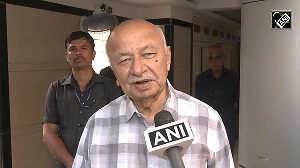India is a world leader in the gems and jewellery industry, but its exports are dependent entirely on imports of rough diamonds, gold and other coloured gemstones.
Security of supply of raw materials is thus an important issue, said Jairam Ramesh, minister of State of Commerce. India now imports close to $8 billion of rough diamonds.
To this end, the minister said that he has been having detailed discussions over the past three months with the ambassadors of a number of countries including Russia, Canada, Australia, South Africa, Namibia, Lesotho, Botswana, Ghana, Angola, Azerbaijan, Armenia, Uzbekistan and Venezuela.
Negotiations between MMTC and Alrosa of Russia are in an advanced stage and we could expect the finalisation of a joint venture in 2007, added Ramesh. The forthcoming visit of President Putin to India will add an extra momentum to this process.
In his meetings with African countries, Ramesh has been stressing India's commitment to ensuring "win-win" partnerships for both sides with India helping African countries build their local industry through technical assistance, while securing access to sources of rough diamonds.
Ramesh revealed that preliminary explorations carried out by global companies in Madhya Pradesh, Chhattisgarh and Andhra Pradesh have revealed good prospects for diamonds and coloured gemstones. Over the next decade with aggressive exploration and development, Indian sources could also be developed.
Ramesh highlighted the importance of the diamond sector particularly, which today accounts for 80 per cent of total exports of gems and jewellery and is estimated to employ close to 10 lakh artisans and workers, both directly and indirectly.
This industry is concentrated mainly in Maharashtra and Gujarat. The gold jewellery industry accounts for 15 per cent of gems and jewellery exports and has expanded impressively in Maharashtra, Delhi, Bangalore, Kolkata, Chennai and Hyderabad. The coloured gemstone industry is also growing fast in Rajasthan, Maharashtra and Delhi.
Ramesh complimented the Gems and Jewellery Export Promotion Council for preparing the Vision-2015 roadmap for the gems and jewellery industry in collaboration with KPMG. He said that the vision document is an excellent blueprint, which will be implemented by the Ministry of Commerce in all seriousness and sense of purpose.
Ramesh said that the vision document had outlined threats and opportunities in great detail. Growing competition from China, rise of new materials like palladium and steel, development of synthetic diamonds, consolidation in the world diamond industry and growth of new cost-effective cutting techniques are all possible scenarios, which India has to plan for systematically.
Ramesh mentioned that India's position in the world gems and jewellery industry has earned it the prestigious position of vice-chairman of the Kimberly process with the possibility of being chairman in 2008. The Kimberly process is a global initiative to certify that shipments of rough diamonds are free from "conflict diamonds". India will provide technical assistance to African countries to ensure that they meet with the Kimberly process certification standards.
Ramesh asked the GJEPC to develop new areas for the industry within the country. As an example, he mentioned the fact that thousands of workers from Orissa work in the diamond cutting and polishing industry in Surat. He asked the GJEPC to explore how backward states like Orissa can generate employment and value-addition in the gems and jewellery industry.
The commerce ministry has provided extensive assistance to establish the Indian Institute of Gems and Jewellery in Mumbai and the Sardar Vallabhbhai Institute for Jewellery Design and Manufacture in Surat. An expansion of the Indian Diamond Institute in Surat is also on the anvil. Maikanchan SEZ in Kolkata is the first-ever project in this industry and another SEZ is being developed in Sitapura near Jaipur.
The minister also disclosed that the M R Sivaraman Committee set up by the finance ministry at the initiative of the commerce ministry to recommend a growth-oriented fiscal regime for the gems and jewellery industry has recently submitted its report.
The fiscal regime seeks to strengthen India's global position and make Mumbai the world hub, replacing Antwerp. Ramesh was hopeful that the forthcoming Budget would reflect the recommendations of the committee headed by the former revenue secretary.






 © 2025
© 2025